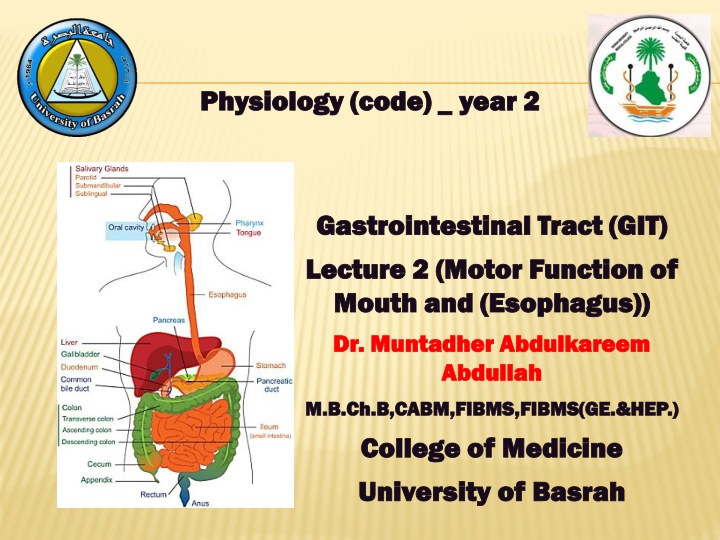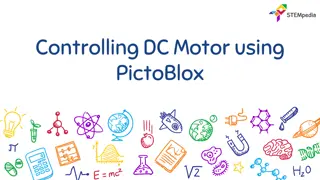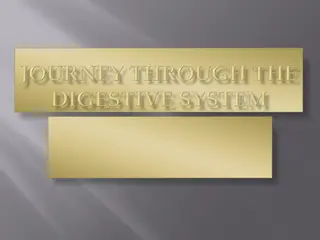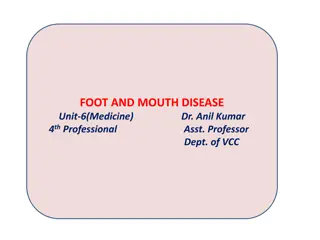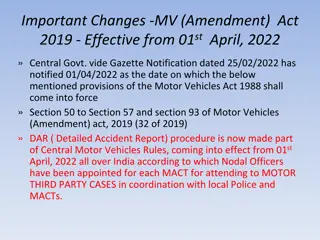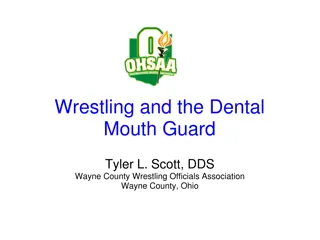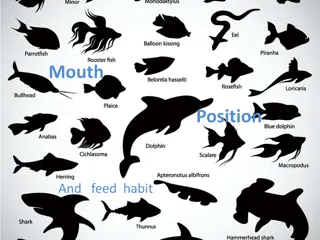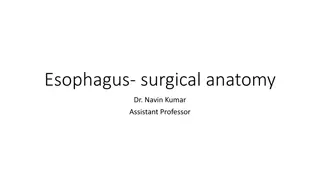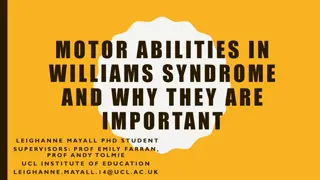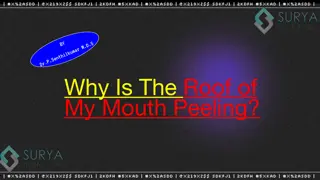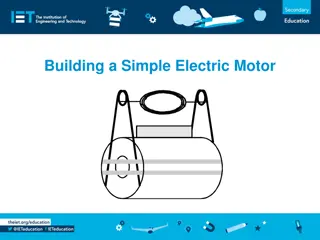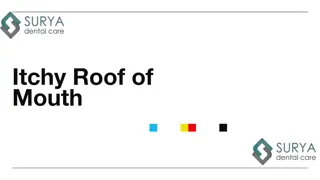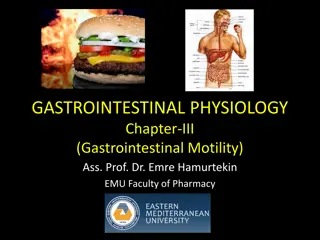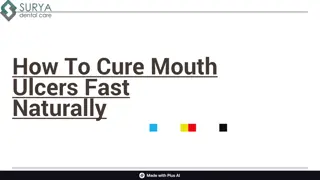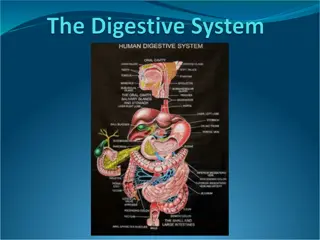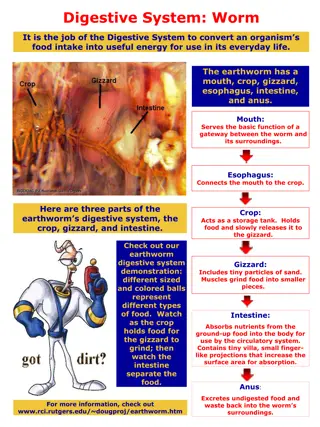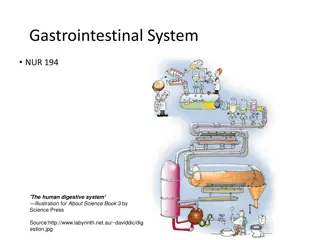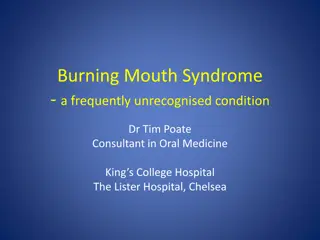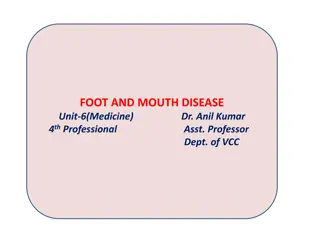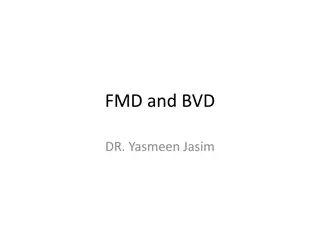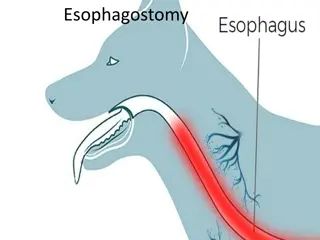Motor Function of Mouth and Esophagus
This content explores the motor functions of the mouth and esophagus, including the process of chewing, swallowing, and the control mechanisms involved. It discusses the physiological aspects of these functions and their importance in the gastrointestinal tract.
Download Presentation

Please find below an Image/Link to download the presentation.
The content on the website is provided AS IS for your information and personal use only. It may not be sold, licensed, or shared on other websites without obtaining consent from the author.If you encounter any issues during the download, it is possible that the publisher has removed the file from their server.
You are allowed to download the files provided on this website for personal or commercial use, subject to the condition that they are used lawfully. All files are the property of their respective owners.
The content on the website is provided AS IS for your information and personal use only. It may not be sold, licensed, or shared on other websites without obtaining consent from the author.
E N D
Presentation Transcript
Physiology ( Physiology (code) _ code) _ year year 2 2 Gastrointestinal Tract (GIT) Gastrointestinal Tract (GIT) Lecture Lecture 2 2 (Motor Function of (Motor Function of Mouth and (Esophagus)) Mouth and (Esophagus)) Dr. Muntadher Abdulkareem Dr. Muntadher Abdulkareem Abdullah Abdullah M.B.Ch.B,CABM,FIBMS,FIBMS(GE.&HEP.) M.B.Ch.B,CABM,FIBMS,FIBMS(GE.&HEP.) College of Medicine College of Medicine University of University of Basrah Basrah
Objectives: Describe the functions of the mouth and the esophagus and the control of that functions. University of Basrah-College of Medicine-Physiology Department 1
Mouth Mouth It is important for chewing of food and mastication. Food will be destroyed into small particles and this increases the surface area of food exposed to secretion. This is under the control of extrinsic nervous system and it is usually done by trigeminal and facial nerves University of Basrah-College of Medicine-Physiology Department 2
Chewing started voluntary but it will continue automatically by automatic reflex because when food touch the roof of the mouth reflex inhibition of masseter muscle drop of mandible stretch of masseter muscle reflex contraction of master muscles food will touch the roof of the mouth again . . The chewing center is located in the medulla oblongata. The importance of chewing are: University of Basrah-College of Medicine-Physiology Department 3
1. Breaks down the indigestible cellulose membranes around the nutrient portions of food 2. Increase the surface area of food so the rate of digestion of food by digestive enzymes is increase. 3. Mixes the food with salivary secretions, which initiates the process of starch digestion(by salivary amylase) and lipid digestion(by lingual lipase) and lubricate and soften the bolus of food, making it easier to swallow. 4. Brings food into contact with taste receptors and releases odors that stimulate the olfactory receptors, which lead to increase the pleasure of eating and initiate gastric secretions. University of Basrah-College of Medicine-Physiology Department 4
Swallowing (deglutition): Swallowing is a complicated mechanism because the pharynx most of the time subserves other functions (e.g. respiration). Swallowing can be divided into: University of Basrah-College of Medicine-Physiology Department 5
1. Voluntary (oral) phase: it is done by the tongue . Thus the tongue forces the bolus of food into the pharynx. Then the second stage started. 2. Involuntary (pharyngeal) phase: swallowing receptors located around the opening of the pharynx (stimulated by food) impulses transmitted by sensory division of trigeminal and glossopharyngeal nerves swallowing centre (medulla oblongata and lower portion of pons) University of Basrah-College of Medicine-Physiology Department 6
motor impulses to pharynx and upper esophagus cause swallowing are transmitted by [5th(trigeminal N), 9th(glossopharyngeal N), 12th(hypoglossal N) cranial nerves and even a few of the superior cervical nerves) series of automatic pharyngeal muscular contractions. The swallowing centre specifically inhibits the respiratory centre of the medulla during swallowing, halting respiration at any point in it is cycle to allow swallowing to proceed. The sequence of events of the pharyngeal stage of the swallowing are as follows: that 10th(vagus N), and University of Basrah-College of Medicine-Physiology Department 7
The soft palate is pulled upward to close the posterior nares and preventing reflex of food into the nasal cavities. University of Basrah-College of Medicine-Physiology Department 8
The palatopharyngeal folds on either side of the pharynx are pulled medialward to approximate each other forming sagital slit through which the food must pass into the posterior pharynx. This slit performs a selective action, allowing food that has been masticated properly to pass with ease, while impending the passage of large objects. University of Basrah-College of Medicine-Physiology Department 9
The vocal cords approximated and epiglottis swing backward over the superior opening of the larynx prevent passage of food into the trachea. of the larynx are strongly University of Basrah-College of Medicine-Physiology Department 10
The(upper esophageal sphincter- pharyngeoesophageal muscle which is a striated muscle), relaxes, thus allowing the food to move easily from the posterior pharynx into the upper esophagus. This sphincter between swallow, remain tonically contracted to prevent the air from passing into the esophagus during respiration. sphincter-cricopharyngeal University of Basrah-College of Medicine-Physiology Department 11
The superior constrictor muscle of the pharynx contracts, giving rise to rapid peristaltic wave passing downward over the middle and inferior pharyngeal muscles and into the esophagus, which propels the food into the esophagus. University of Basrah-College of Medicine-Physiology Department 12
3. Esophageal stage of swallowing: The esophagus functions to conduct food from the pharynx to the stomach. Esophagus exhibits two types of peristaltic movements Primary peristalsis which a continuation of the peristaltic wave that begins in the pharynx which passes all the way from the pharynx to the stomach through esophagus. The peristaltic waves of the esophagus are initiated by vagal reflexes. These reflexes are transmitted through vagal afferent fibers from the esophagus to the medulla and then back again to the esophagus through vagal efferent fibers. University of Basrah-College of Medicine-Physiology Department 13
Secondary peristalsis which is generated by the ENS of the esophagus itself, initiated from distension of the esophagus by the retained food if the primary peristalsis fails to move all the food that has entered the esophagus into the stomach. University of Basrah-College of Medicine-Physiology Department 14
Receptive relaxation of the stomach: As the esophageal peristaltic wave passes toward gastroesophageal sphincter, the entire stomach and to lesser extent even the duodenum become relaxed as this wave reaches the lower end of the esophagus. the stomach, the University of Basrah-College of Medicine-Physiology Department 15
To prevent reflux of the acidic contents of the stomach up to the esophagus which may cause a damage to esophageal mucosa: 1. The muscle of lower esophageal sphincter normally remains tonically contracted, due tonic activity of the vagal fibers. 2. The valve like mechanism of that portion of the esophagus that lies immediately beneth the diaphragm due to increased intra- abdominal pressure caves the esophagus inward at this point. University of Basrah-College of Medicine-Physiology Department 16
Disorders of swallowing: 1. Esophageal reflux: Reflux of stomach acid to the esophagus causes esophageal pain(heart burn), it may occur if: a. Intra gastric pressure rises high enough to force the lower esophageal sphincter open. b. If the lower esophageal sphincter is un able to maintain it is normal tone. c. If the lower esophageal sphincter is forced through the diaphragm and into the thoracic cavity as in hiatal hernia. In either case, the low intrathoracic pressure compared to the high intra- abdominal pressure causes the lower esophageal sphincter to expand. University of Basrah-College of Medicine-Physiology Department 17
2. Belching (eructation): Following a heavy meal or the ingestion of large amount of gas. The gas bubble that is usually in the fundus of the stomach is displaced to the cardia, and when lower esophageal sphincter relaxes during the swallowing process, the gas enters the esophagus and it is regurgitated. 3. Achalasia: It is a neuromuscular disorder of the lower two-thirds of the esophagus, that lead to absence of peristalsis and failure of the lower esophageal sphincter to relax. University of Basrah-College of Medicine-Physiology Department 18
Recap: The motor activity of mouth called chewing of food and mastication. This is under the control of extrinsic nervous system and it is usually done by trigeminal and facial nerves. Swallowing is a motor activity of esophagus and divided to three phases which are :Voluntary (oral) phase, Involuntary (pharyngeal) Esophageal stage of swallowing. As the esophageal peristaltic wave passes toward the stomach, the gastroesophageal sphincter, the entire stomach and to lesser extent even the duodenum become relaxed as this wave reaches the lower end of the esophagus. phase and the University of Basrah-College of Medicine-Physiology Department 19
Questions: Explain why: 1. Only food that has been masticated properly can pass with ease through the pharynx. 2. Normally, there is no reflex of the acidic contents of the stomach up to the esophagus. University of Basrah-College of Medicine-Physiology Department 20
